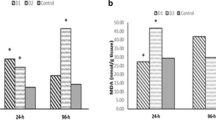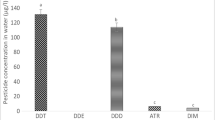Abstract
The high demand for food consequently increases the entry of agricultural residues into water resources, and this phenomenon can affect non-target organisms in different ways. Environmentally relevant pesticide effects (per se or in combinations) are scarce in the scientific literature. Therefore, the aim of this study was to investigate: (1) the presence of pesticide residues in an important Brazilian source of water supply and power generation (Jacuí river), during 1 year of monitoring. (2) in a laboratory study verify the effects of the most frequently, herbicide, fungicide, and insecticide found in Jacuí river (individualized or in a mixture) on biochemical parameters in different tissues of Oreochromis niloticus. Twenty pesticide residues were detected in superficial water samples, and two of them are banned in Brazilian territory. Atrazine (0.56 µg L−1), azoxystrobin (0.024 µg L−1), and imidacloprid (0.11 µg L−1) were the most frequently herbicide, fungicide, and insecticide, respectively, found in the river and were used in the laboratory assay. O. niloticus exposed to the pesticide mixture exhibited more biochemical effects than individualized exposure groups. This response can be a result of the combined pesticide effects, culminating in an additive or synergistic effect, depending on the biomarker. In individual exposure groups, atrazine presented the most pronounced alterations, followed by azoxystrobin and imidacloprid. Overall, pesticide exposure increased levels of oxidative stress parameters, reduced antioxidant enzyme activities, and induced acetylcholinesterase activity. These findings highlight the threat to aquatic organisms which may be exposed to a miscellaneous of toxic compounds in the environment.




Similar content being viewed by others
References
ADAPAR—Agência de Defesa Agropecuária do Paraná (2020). http://www.adapar.pr.gov.br/modules/conteudo/conteudo.php?conteudo=389. Accessed 16 Jul 2020
Aebi H (1984) Catalase in vitro. Methods Enzymol 105:121–126
Ajima M, Pandey P, Kumar K, Poojary N (2017) Neurotoxic effects, molecular responses and oxidative stress biomarkers in Nile tilapia, Oreochromis niloticus (Linnaeus, 1758) exposed to verapamil. Comp Biochem Physiol C Toxicol Pharmacol 196:44–52. https://doi.org/10.1016/j.cbpc.2017.03.009
ANVISA—Agência Nacional de Vigilância Sanitária (2002) RDC no. 347 de 16 de dezembro de 2002
ANVISA—Agência Nacional de Vigilância Sanitária (2010) RDC no. 37 de 16 de agosto de 2010
Araújo C, Silva D, Gomes L, Acayaba R, Montagner C, Moreira-Santos M, Ribeiro R, Pompêo M (2018) Habitat fragmentation caused by contaminants: atrazine as a chemical barrier isolating fish populations. Chemosphere 193:24–31. https://doi.org/10.1016/j.chemosphere.2017.11.014
Bacolod E, Uno S, Villamor S, Koyama J (2017) Oxidative stress and genotoxicity biomarker responses in tilapia (Oreochromis niloticus) exposed to environmental concentration of 1-nitropyrene. Mar Pollut Bull 124:786–791. https://doi.org/10.1016/j.marpolbul.2017.01.077
Barbieri E, Ferreira L (2011) Effects of the organophosphate Folidol 600 on the freshwater fish, Nile Tilapia (Oreochromis niloticus). Pestic Biochem Physiol 99:209–214
Bartlett DW, Clough JM, Godwin JR, Hall AA, Hamer M, Parr-Dobrzanski B (2002) The strobilurin fungicides. Pest Manag Sci 58(7):649–662. https://doi.org/10.1002/ps.520
Beliaeff B, Burgeot T (2002) Integrated biomarker response: a useful tool for ecological risk assessment. Environ Toxicol Chem 21:1316–1322
Birnie-Gauvin K, Costantini D, Cooke S, Willmore W (2017) A comparative and evolutionary approach to oxidative stress in fish: a review. Fish Fish 18:928–942. https://doi.org/10.1111/faf.12215
Bradford MMA (1976) A rapid and sensitive method for the quantification of microgram quantities of protein utilizing the principle of protein-dye binding. Anal Biochem 72:248–254
Brodeur J, Sanchez M, Castro L, Rojas D, Cristos D, Damonte M, Poliserpi M, D’Andrea M, Andriulo A (2017) Accumulation of current-use pesticides, cholinesterase inhibition and reduced body condition in juvenile one-sided livebearer fish (Jenynsia multidentata) from agricultural Pampa region of Argentina. Chemosphere 185:36–46. https://doi.org/10.1016/j.chemosphere.2017.06.129
Cedergreen N (2014) Quantifying synergy: a systematic review of mixture toxicity studies within environmental toxicology. PLoS ONE 9(5):e96580. https://doi.org/10.1371/journal.pone.0096580
Cerezer C, Marins AT, Cerezer FO, Severo ES, Leitemperger JW, Bandeira NMG, Zanella R, Loro VL, Santos S (2020) Influence of pesticides and abiotic conditions on biochemical biomarkers in Aegla aff. longirostri (crustacea, anomura): implications for conservation. Ecotoxicol Environ Saf 203:110982. https://doi.org/10.1016/j.ecoenv.2020.110982
Clasen B, Loro VL, Murussi CR, Tiecher TL, Moraes B, Zanella R (2018) Bioaccumulation and oxidative stress caused by pesticides in Cyprinus carpio reared in a rice-fish system. Sci Total Environ 626:737–743. https://doi.org/10.1016/j.scitotenv.2018.01.154
CONAMA—Conselho Nacional do Meio Ambiente (2005) Resolução no. 357 de 17 de março de 2005. Diário Oficial da União. No. 53, pp. 58–63. Accessed 18 Mar 2020
Crosby EB, Bailey JM, Oliveri AN, Levin ED (2015) Neurobehavioral impairments caused by developmental imidacloprid exposure in zebrafish. Neutoroxicol Teratol 49:81–90. https://doi.org/10.1016/j.ntt.2015.04.006
de Almeida M, Pereira T, Batlouni S, Boscolo C, de Almeida E (2018) Estrogenic and anti-androgenic effects of the herbicide tebuthiuron in male Nile Tilapia (Oreochromis niloticus). Aquat Toxicol 194:86–93. https://doi.org/10.1016/j.aquatox.2017.11.006
de Albuquerque FP, de Oliveira JL, Moschini-Carlos V, Fraceto LF (2020) An overview of the potential impacts of atrazine in aquatic environments: perspectives for tailored solutions based on nanotechnology. Sci Total Environ 700:134868. https://doi.org/10.1016/j.scitotenv.2019.134868
Demirci Ö, Güven K, Asma D, Öğüt S, Uğurlu P (2018) Effects of endosulfan, thiamethoxan, and indoxacarb in combination with atrazine on multi-biomarkers in Gammarus kischineffensis. Ecotoxicol Environ Saf 147:749–758. https://doi.org/10.1016/j.ecoenv.2017.09.038
do Amaral A, Gomes J, Weimer G, Marins A, Loro V, Zanella R (2018) Seasonal implications on toxicity biomarkers of Loricariichthys anus (Valenciennes, 1835) from a subtropical reservoir. Chemosphere 191:876–885. https://doi.org/10.1016/j.chemosphere.2017.10.114
Donato F, Martins M, Munaretto J, Prestes O, Adaime M, Zanella R (2015) Development of a multiresidue method for pesticide analysis in drinking water by solid phase extraction and determination by gas and liquid chromatography with triple quadrupole tandem mass spectrometry. J Braz Chem Soc 26:2077–2087. https://doi.org/10.5935/0103-5053.20150192
dos Santos D, Yamamoto F, Filipak Neto F, Randi M, Garcia J, Costa D, Liebel S, Campos S, Voigt C, Ribeiro C (2016) The applied indicators of water quality may underestimate the risk of chemical exposure to human population in reservoirs utilized for human supply-Southern Brazil. Environ Sci Pollut Res 23:9625–9639. https://doi.org/10.1007/s11356-015-5995-0
Draper H, Hadley M (1990) Malondialdehyde determination as index of lipid peroxidation. Methods Enzymol 186:421–431
Ellman G, Courtney K, Andres J (1961) A new and rapid colorimetric determination of acetylcholinesterase activity. Biochem Pharmacol 7:88–95
Felício A, Freitas J, Scarin J, Ondei L, Teresa F, Schelenk D, de Almeida E (2018) Isolated and mixed effects of diuron and its metabolites on biotransformation enzymes and oxidative stress response of Nile tilapia (Oreochromis niloticus). Ecotoxicol Environ Saf 149:248–256. https://doi.org/10.1016/j.ecoenv.2017.12.009
Furley TH, Brodeur J, de Assis HCS, Carriquiriborde P, Chagas KR, Corrales J, Denadai M, Fuchs J, Mascarenhas R, Miglioranza KSB, Carames DMM, Navas JM, Nugegoda D, Planes E, Rodriguez-Jorquera IA, Orozco-Medina M, Boxall ABA, Rudd MA, Brooks BW (2018) Toward sustainable environmental quality: Identifying priority research questions for Latin America. Integr Environ Assess Manag 14(3):344–357. https://doi.org/10.1002/ieam.2023
Gaaied S, Oliveira M, Le Bihanic F, Cachot J, Banni M (2019) Gene expression patterns and related enzymatic activities of detoxification and oxidative stress systems in zebrafish larvae exposed to the 2,4-dichlorophenoxyacetic acid herbicide. Chemosphere 224:289–297. https://doi.org/10.1016/j.chemosphere.2019.02.125
Guzmán-Guillén R, Ortega A, Martín-Caméan A, Cameán A (2015) Beneficial effects of vitamin E supplementation against the oxidative stress on cylindrospermopsin-exposed tilapia (Oreochromis niloticus). Toxicon 104:34–42. https://doi.org/10.1016/j.toxicon.2015.07.336
Habig W, Pabst M, Jacoby W (1974) Glutathione S-transferase, the first enzymatic step in mercapturic acid formation. J Biol Chem 249:7130–7139
Han Y, Liu T, Wang J, Wang J, Zhang C, Zhu L (2016) Genotoxicity and oxidative stress induced by the fungicide azoxystrobin in zebrafish (Danio rerio) livers. Pestic Biochem Physiol 133:13–19. https://doi.org/10.1016/j.pestbp.2016.03.011
Hladik M, Corsi S, Kolpin D, Baldwin A, Blackwell B, Cavallin J (2018) Year-round presence of neonicotinoid insecticides in tributaries to the Great Lakes, USA. Environ Pollut 235:1022–1029. https://doi.org/10.1016/j.envpol.2018.01.013
IBAMA—Instituo Brasileiro do Meio Ambiente e dos Recursos Naturais Renováveis (2020) Relatórios de comercialização de agrotóxicos. https://www.ibama.gov.br/agrotoxicos/relatorios-de-comercializacao-de-agrotoxicos#boletinsanuais. Accessed 6 Jul 2020
IBGE—Instituto Brasileiro de Geografia e Estatística (2018) Produção agrícola municipal, tabela 3.21—Rio Grande do Sul. https://www.ibge.gov.br/estatisticas-novoportal/economicas/agricultura-e-pecuaria/9117-producao-agricola-municipal-culturas-temporarias-e-permanentes.html?&t=resultados. Accessed 22 Jan 2018
Iturburu FG, Zömisch M, Panzeri AM, Crupkin AC, Contardo-Jara V, Pflugmacher S, Menone ML (2017) Uptake, distribution in different tissue, and genotoxicity of imidacloprid in the freshwater fish Australoheros facetus. Environ Toxicol Chem 36(3):699–708. https://doi.org/10.1002/etc.3574
Jeschke P, Nauen R, Schindler M, Elbert A (2011) Overview of the status and global strategy for neonicotinoids. J Agric Food Chem 59(7):2897–2908. https://doi.org/10.1021/jf101303g
Jiang J, Shi Y, Yu R, Chen L, Zhao X (2018) Biological response of zebrafish after short-term exposure to azoxystrobin. Chemosphere 202:56–64. https://doi.org/10.1016/j.chemosphere.2018.03.055
Kumar N, Willis A, Satbhai K, Ramalingam L, Schimitt C, Moustaid-Moussa N, Crago J (2020) Developmental toxicity in embryo-larval zebrafish (Danio rerio) exposed to strobilurin fungicides (azoxystrobin and pyraclostrobin). Chemosphere 241:124980. https://doi.org/10.1016/j.chemosphere.2019.124980
Liu L, Jiang C, Wu Z, Gong Y, Wang G (2013) Toxic effects of three strobilurins (trifloxystrobin, azoxystrobin and kresoxim-methyl) on mRNA expression and antioxidant enzymes in grass carp (Ctenopharyngodon idella) juveniles. Ecotoxicol Environ Saf 98:297–302. https://doi.org/10.1016/j.ecoenv.2013.10.011
López-Doval J, Montagner C, de Albuquerque A, Moschini-Carlos V, Umbuzeiro G, Pompêo M (2017) Nutrients, emerging pollutants and pesticides in a tropical urban reservoir: spatial distributions and risk assessment. Sci Total Environ 575:1307–1324. https://doi.org/10.1016/j.scitotenv.2016.09.210
Loro V, Murussi C, Menezes C, Leitemperger J, Severo E, Guerra L, Costa M, Perazzo G, Zanella R (2015) Spatial and temporal biomarkers responses of Astyanax jacuhiensis (Cope, 1894) (Characiformes: Characidae) from the middle rio Uruguai, Brazil. Neotrop Ichthyol 13:569–578. https://doi.org/10.1590/1982-0224-20140146
Lushchak V (2015) Contaminant-induced oxidative stress in fish: a mechanistic approach. Fish Physiol Biochem 42(2):711–747. https://doi.org/10.1007/s10695-015-0171-5
Marins A, Rodrigues C, de Menezes C, Gomes J, Costa M, Nunes M, Vieira M, Donato F, Zanella R, da Silva L, Loro V (2018) Integrated biomarkers response confirm the antioxidant role of diphenyl diselenide against atrazine. Ecotoxicol Environ Saf 151:191–198. https://doi.org/10.1016/j.ecoenv.2018.01.021
Marins AT, Severo ES, Leitemperger JW, Cerezer C, Müller TE, Costa MD, Weimer GH, NMG Bandeira, Prestes OD, Zanella R, Loro VL (2020) Assessment of river water quality in an agricultural region of Brazil using biomarkers in a native neotropical fish, Astyanax spp. (Characidae). Bull Environ Contam Toxicol 104:575–581. https://doi.org/10.1007/s00128-020-02821-0
Müller T, Nunes M, Menezes C, Marins A, Leitemperger J, Gressler A, Carvalho F, de Freitas C, Quadros V, Fachinetto R, Rosemberg D, Loro V (2017) Sodium selenite prevents paraquat-induced neurotoxicity in zebrafish. Mol Neurobiol 55:1928–1941. https://doi.org/10.1007/s12035-017-0441-6
Murussi CR, Costa M, Menezes C, Leitemperger J, Guerra L, Lópes T, Severo E, Zanella R, Loro VL (2015) Integrated assessment of biomarker response in carp (Cyprinus carpio) and silver catfish (Rhamdia quelen) exposed to clomazone. Arch Environ Contam Toxicol 68:646–654. https://doi.org/10.1007/s00244-015-0145-8
Nunes M, Müller T, Braga M, Fontana B, Quadros V, Marins A, Rodrigues C, Menezes C, Rosemberg D, Loro V (2017) Chronic treatment with paraquat induces brain injury, changes in antioxidant defenses system, and modulates behavioral functions in zebrafish. Mol Neurobiol 54:3925–3934. https://doi.org/10.1007/s12035-016-9919-x
Olsvik P, Kroglund F, Finstad B, Kristensen T (2010) Effects of the fungicide azoxystrobin on atlantic salmon (Salmo salar L.) smolt. Ecotoxicol Environ Saf 73:1852–1861. https://doi.org/10.1016/j.ecoenv.2010.07.017
Parvez S, Raisuddin S (2005) Protein carbonyls: novel biomarkers of exposure to oxidative stress-inducing pesticides in freshwater fish Channa punctate (Bloch). Environ Toxicol Pharmacol 20:112–117. https://doi.org/10.1016/j.etap.2004.11.002
Pereira L, Fernandes MN, Martinez CBR (2013) Hematological and biochemical alterations in fish Prochilodus lineatus caused by the herbicide clomazone. Environ Toxicol Pharmacol 36:1–8. https://doi.org/10.1016/j.etap.2013.02.019
PubChem—Open chemistry database. Azinphos-ethyl, CID: 17531. https://pubchem.ncbi.nlm.nih.gov/compound/17531. Accessed 16 Jul 2020a
PubChem—Open chemistry database. Trichlorfon, CID: 5853. https://pubchem.ncbi.nlm.nih.gov/compound/5853. Accessed 16 July 2020b
PubChem—Open chemistry database. Atrazine, CID: 2256. https://pubchem.ncbi.nlm.nih.gov/compound/atrazine#section=Top. Accessed 04 March 2020c
PubChem—Open chemistry database. Imidacloprid, CID: 86418. https://pubchem.ncbi.nlm.nih.gov/compound/Imidacloprid#section=Top. Accessed in 04 March 2020d
Rossi AS, Fantón N, Michlig MP, Repetti MR, Cazenave J (2020) Fish inhabiting rice fields: bioaccumulation, oxidative stress and neurotoxic effects after pesticides application. Ecol Indic 113:106186. https://doi.org/10.1016/j.ecolind.2020.106186
Samson-Robert O, Labrie G, Chagnon M, Fournier V (2017) Planting of neonicotinoid-coated corn raises honey bee mortality and sets back colony development. Peer J 5:e3670. https://doi.org/10.7717/peerj.3670
Sanchez W, Burgeot T, Porcher J (2013) A novel “integrated biomarker response” calculation based on reference deviation concept. Environ Sci Pollut Res 20:2721–2725
Shukla S, Jhamtani R, Dahiya M, Agarwal R (2017) Oxidative injury caused by individual and combined exposure of neonicotinoid, organophosphate and herbicide in zebrafish. Toxicol Rep 4:240–244. https://doi.org/10.1016/j.toxrep.2017.05.002
Severo ES, Marins AT, Cerezer C, Costa D, Nunes M, Prestes OD, Zanella R, Loro VL (2020) Ecological risk of pesticide contamination in a Brazilian river located near a rural area: a study of biomarkers using zebrafish embryos. Ecotoxicol Environ Saf 190:110071. https://doi.org/10.1016/j.ecoenv.2019.110071
Solomon K, Dalhoff K, Volz D, Kraak G (2014) Effects of herbicides on fish. In: Tierney K, Farrel A, Brauner C (eds.) Organic chemical toxicology of fishes. Fish physiology. Academic Press, Amsterdan, the Netherlands) and Boston (Massachusetts): Elsevier. pp 0.370–403. ISBN: 978-0-12-398254-4
Sparling D (2016) Chapter 3: bioindicators of contaminant exposure. Ecotoxicology essentials: environmental contaminants and their biological effects on animals and plants. pp 45–66. https://doi.org/10.1016/B978-0-12-801947-4.00003-2
Sposito JCV, Montagner CC, Casado M, Navarro-Martín, Solórzano JCJ, Piña B, Grisolia AB (2018) Emerging contaminants in Brazilian rivers: ocurrence and effects on gene expression in zebrafish. Chemosphere 209:696–704. https://doi.org/10.1016/j.chemosphere.2018.06.046
Spurgeon DJ, Jones OAH, Dorne JCM, Svendsen C, Swain S, Stürzenbaum SR (2010) Systems toxicology approaches for understanding the joint effects of environmental chemical mixtures. Sci Total Environ 408:3725–3734. https://doi.org/10.1016/j.scitotenv.2010.02.038
Tian X, Yang W, Wang D, Zhao Y, Yao R, Ma L, Ge C, Li X, Huang Z, He L, Jiao W, Lin A (2018) Chronic brain toxicity response of juvenile Chinese rare minnows (Gobiocypris rarus) to the neonicotinoid insecticides imidacloprid and nitenpyram. Chemosphere 210:1006–1012. https://doi.org/10.1016/j.chemosphere.2018.06.083
Toledo-Ibarra G, Díaz Resendiz K, Ventura-Ramón G, González-Jaime F, Vega-López A, Becerril-Villanueva E, Pavón L, Girón-Pérez M (2016) Oxidative damage in gills and liver in Nile tilapia (Oreochromis niloticus) exposed to diazinon. Comp Biochem Physiol A Mol Integr Physiol 200:3–8. https://doi.org/10.1016/j.cbpa.2016.05.007
Valavanidis A, Vlahogianni T, Dassenakis M, Scoullos M (2006) Molecular biomarkers of oxidative stress in aquatic organisms in relation to toxic environmental pollutants. Ecotoxicol Environ Saf 64(2):178–189. https://doi.org/10.1016/j.ecoenv.2005.03.013
Ventura B, de Angelis D, Marin-Morales M (2008) Mutagenic and genotoxic effects of the Atrazine herbicide in Oreochromis niloticus (Perciformes, Cichlidae) detected by the micronuclei test and the comet assay. Pestic Biochem Physiol 90:42–51. https://doi.org/10.1016/j.pestbp.2007.07.009
Vidal LVO, Albinati RCB, Albinati ACL, de Lira AD, de Almeida TR, Santos GB (2008) Eugenol como anestésico para a tilápia-do-nilo. Pesq Agropec Bras 43:1069–1074
Vieira C, Pérez M, Acayaba R, Raimundo C, Martinez C (2018) DNA damage and oxidative stress induced by imidacloprid exposure in different tissues of the Neotropical fish Prochilodus lineatus. Chemosphere 195:125–134
Vieira CED, Costa PG, Caldas SS, Tesser ME, Risso WE, Escarrone AL, Primel EG, Bianchini A, Martinez CBR (2019) An integrated approach in subtropical agro-ecosystems: Active biomonitoring, environmental contaminants, bioaccumulation, and multiple biomarkers in fish. Sci Total Environ 666:508–524. https://doi.org/10.1016/j.scitotenv.2019.02.209
Wang Y, Yu Y, Yang G, Xu Z, Wang Q, Cai L (2017) Single and joint toxic effects of five selected pesticides on the early life stages of zebrafish (Danio rerio). Chemosphere 170:61–67. https://doi.org/10.1016/j.chemosphere.2016.12.025
WHO—World Health Organization (2009) The WHO recommended classification of pesticides by hazard: and guidelines to classification. ISSN 1684-1042
Wiegand C, Krause E, Steinberg C, Pflugmacher S (2001) Toxicokinetics of atrazine in embryos of the zebrafish (Danio rerio). Ecotoxicol Environ Saf 49:199–205. https://doi.org/10.1006/eesa.2001.2073
Xing H, Li S, Wang Z, Gao X, Xu S, Wang X (2012) Histopathological changes and antioxidant response in brain and kidney of common carp exposed to atrazine and chlorpyrifos. Chemosphere 88:377–383. https://doi.org/10.1016/j.chemosphere.2012.02.049
Zahran E, Risha E, Awadin W, Palic D (2018) Acute exposure to chlorpyrifos induces reversible changes in health parameters of Nile tilapia (Oreochromis niloticus). Aquatic Toxicol 197:47–59
Acknowledgements
This study was supported by the Coordenação de Aperfeiçoamento de Pessoal de Nível Superior—Brasil (CAPES)—Finance Code 001. Vania Lucia Loro received a research fellowship from CNPq (National Research Council), process number: 309314/2017-8. Aline Teixeira Marins received a doctoral fellowship from CAPES. The authors thank the agronomist Rodrigo Roso, Pedro Henrique Pinto Leão, and Renata Teixeira Marins for technical support.
Author information
Authors and Affiliations
Corresponding author
Ethics declarations
Conflict of interest
The authors declare no competing interests.
Ethical statement
This study was approved by Animal Care Committee at University Federal of Santa Maria, under number: 5537261016.
Additional information
Publisher’s note Springer Nature remains neutral with regard to jurisdictional claims in published maps and institutional affiliations.
Supplementary information
Rights and permissions
About this article
Cite this article
Marins, A.T., Severo, E.S., Cerezer, C. et al. Environmentally relevant pesticides induce biochemical changes in Nile tilapia (Oreochromis niloticus). Ecotoxicology 30, 585–598 (2021). https://doi.org/10.1007/s10646-021-02368-8
Accepted:
Published:
Issue Date:
DOI: https://doi.org/10.1007/s10646-021-02368-8




